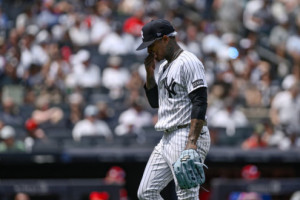Risers and Fallers: Volume 21
![]()
I’m back for another week of reviewing the most interesting players from the past seven days, pairing advanced metrics and insights from my DFS projection system, THE BAT, with my scouting background to try to figure out what to make of some the week’s most active lot of ballplayers.
Guys whose stock is going up, guys whose stock is going down, guys who are perpetually underpriced or overpriced, guys who are worth paying a premium for, or guys who are just interesting and warrant some analysis on.
RISING… SNEAKILY BUT LEGITIMATELY
Jeff Samardzija, SP, San Francisco Giants
Don’t look now, but Samardzija has posted a 2.49 ERA and 3.89 xFIP since August 10. That may seem like cherry-picking data (which I am vehemently against), but August 10 was an important day for Samardzija and is a good jumping off point for evaluating the Shark.
On August 10, Samardzija added a new pitch to his arsenal: a curveball. And it’s a good one. It is both harder and tighter (i.e. generates more velocity and spin) than the average curveball (not by large amounts, but by enough), and when it’s added to the arsenal of a pitcher who already throws five pitches, its effectiveness is increased. This is especially true when you consider what those other five pitches are and how the curveball hits in with them. Samardzija’s fastball sits at 95 mph, and his slowest secondary offering was an 86-mph splitter. That’s just a 9-mph gap, but adding a pitch on the low end—in this case, the curve at 80 mph—widens that gap to 14-mph, helping to keep hitters off balance and increase the effectiveness of his other pitches.
And that’s to say nothing of the curveball itself which, in the limited sample that Samardzija has thrown it, is already one of the most effective curveballs in baseball in terms of raw outcomes while generating both whiffs and groundballs. Obviously a new pitch isn’t solely responsible for such a big turnaround, but it certainly helps. When you consider the likelihood that some positive regression was already due for Samardzija, it seems pretty safe to trust him again in good matchups.
He struggled a bit against the Padres on Monday night, but I’m viewing Samardzija as an above-average pitcher with big strikeout upside going forward. He’ll get the Cardinals this week, followed by the Padres again, and then the Rockies at home in AT&T to close out the year, so we will definitely have some chances to exploit this new version of Shark.

Marcus Stroman, SP, Toronto Blue Jays
Stroman is an interesting case study because, up until recently, he was never quite the pitcher that we expected him to be as a prospect. The biggest concern of scouts was Stroman’s size and durability and his ability to hold up as a starter. The stuff was never in question, drawing raves and creating a floor of a knockout reliever but with the ability to be a front-line starter if he could handle the workload. And yet, after 325 innings across three seasons as a starter, Stroman’s 7.5 K/9 sits firmly average.
Of course, while Stroman’s secondary pitches (particularly his slider) are excellent, he’s a sinkerball pitcher. Sure, he throws that sinker at 93-mph, but it’s the rare sinkerballer that is capable of generating an elite strikeout rate, especially when the sinker is used 55 percent of the time as it has been this year. That is, it was used 55 percent of the time up until a few weeks ago. It seems as though Stroman has realized that this isn’t the ideal way to generate strikeouts and wants more of them, because his sinker usage has been in steady decline. More importantly, though, a big part of this usage has been replaced by his slider, which was used just 7% in 2014, 14% in 2015, and 15% in the first half of 2016. Over the past five weeks, however, Stroman’s slider usage has ramped up to 22% and his sinker usage is down to 41%. This would definitely help explain the jump in K/9 to 9.3 over that period and makes Stroman a much more appealing DFS option going forward.
It’s difficult to quantify exactly how much of the strikeout jump is real and how much is mere variance (after all, jumping close to two full strikeouts per nine innings is enormous and we’re dealing with a relatively small sample), but this type of thing is on the top of my to-do list for this offseason. Quantifying stuff, evaluating how it impacts on-field performance, and setting THE BAT up to more accurately account for who the pitcher is right now at this more granular level. For now, I’m content nudging Stroman up a couple points or locking him in for good matchups. On such matchup could come Tuesday night as he faces a Tampa Bay Rays team this is generally pretty easy to pick on. After that he’ll face the Angels in Anaheim followed by the strikeout-prone Yankees and Orioles at home in the Trop. Especially at a reasonable $9,000 on DraftKings and $7,800 on FanDuel, Stroman should absolutely be on our radar for each of his remaining starts.
RISING… AND I’M NOW BEGGING YOU TO JUMP ON BOARD
Rich Hill, SP, Los Angeles Dodgers
Guys, I told you that Hill was going to be amazing with the Dodgers. If you didn’t play him Saturday night, especially on two-pitcher sites, shame on you. If he’s not one of the top pitchers on your board every single time out (unless Carlos Ruiz is catching), he really needs to be. This guy’s stuff is ridiculous, his strikeout upside is enormous, and he’s in the perfect situation right now. Even going into Arizona this week, he’s still going to be an elite play (and perhaps one people will ignore due to the righty-heavy nature of their lineup and Chase Field). I’ve written him up before so I won’t spend any more time on it, but I wasn’t kidding when I said he’d be one of the best pitchers in baseball down the stretch, and I continue to stand by it.

RISING… AND UNDERPRICED
Roman Quinn, OF, Philadelphia Phillies
One of Philly’s most intriguing prospects drew his first ever major league start on Sunday, and followed it up with another on Monday. And boy was the latter a good one. I touted Quinn as a great stolen base option for GPPs, and he went and did much more than that. He went 2-for-4 with two doubles, a walk, two RBIs… oh, and that steal I wanted. Most notably, though, is that he batted second in both games and cost just $2,600 on DraftKings, which means he could be interesting going forward if this big game doesn’t jack up his price.
Quinn is a prospect in the mold of Billy Hamilton. He has elite, 80-grade speed (almost as fast as Hamilton himself) but projects to have some trouble getting on base if his elite BABIPs don’t translate to the majors. He doesn’t draw many walks, strikes out at a slightly above-average clip, and has very little power. Hamilton certainly makes that skillset work, though, and Quinn will only run you a fraction of the cost. He just turned 23 this season and hasn’t played a single game above Double-A until this weekend, however, and so it would be premature to anoint him the next Hamilton just yet. For all Hamilton’s shortcomings, he has found a way to generate enough hits at the major league level, which Quinn hasn’t proven yet. Still, he’ll be interesting to keep an eye on and use as the occasional punt with stolen base upside if he continues to hit second.
Tom Murphy, C, Colorado Rockies
With rosters expanding this month, the Rockies called up catcher prospect Tom Murphy. As you can imagine, this is extremely interesting because, you may have heard, but the Rockies play in this park that’s pretty good for offense. Murphy isn’t necessarily an offensive juggernaut, but catchers are scarce. And he’s certainly competent offensively, especially in the power department.
Murphy, essentially, is Nick Hundley quality with more strikeouts and more home runs. While I’ve only recommended playing Hundley a handful of times this season, that has more to do with price than talent. In matchups that are good for the Rockies, Hundley tends to sit in the $3,500-to-$4,000 range on DraftKings and $3,000 on FanDuel. That’s usually too expensive for a guy that gets buried at the bottom of the order, but Murphy is different. Not only do his skills tilt more towards the DFS categories that generate the biggest points, but he also costs significantly less than Hundley. He costs in the mid-$2,000s on DraftKings and the low-$2,000s on FanDuel, which makes him an excellent punt on days he starts and the Rockies are in play.
Of course, the Rockies now have three catchers to divvy out starts to, and Murphy may well be bottom of the totem pole, but they have been split pretty evenly of late, and the sporadic nature of the starts should serve to keep his price low. The Rockies will finish off a series in Chase Field over the next couple days before going back to Coors for a week, so keep a close eye on Murphy.